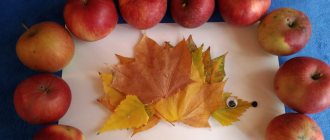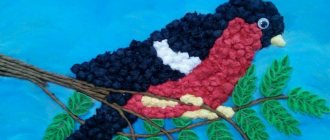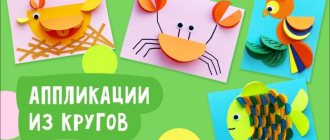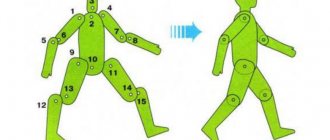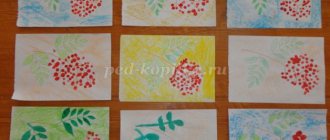Tasks. Teach children to cut out houses from paper folded like an accordion or twice in half. Improve the technique of cutting with scissors: by eye in a straight line (walls of houses), along an oblique (roofs) and along folds (windows). To develop compositional skills - when creating a panorama of the city, rhythmically arrange houses in rows, starting from the top and partially overlapping the images.
Preliminary work. In independent artistic activity, a small group of children prepares the basis for a future composition - they tint a large sheet of paper or a strip of wallpaper, dividing the space into two parts (2/3 - green or yellow-brown ground; at the very bottom two stripes of a gray road, separated by white markings; 1/3 - blue or dark blue sky - see figure). A city tour or looking at illustrations and postcards with city panoramas.
Materials, tools, equipment. Strips of colored paper of different widths for cutting out buildings, rectangles and strips of colored paper for cutting out windows, simple pencils, scissors, glue, glue brushes, oilcloths, napkins, paper and cloth, a large sheet of paper or a strip of wallpaper to create an overall composition.
Contents of the lesson.
The teacher shows the children the basis for the future composition, explains that now there is space - the earth (the bottom of the sheet) to the horizon (holds his hand, showing the horizon line) and the sky. But soon, soon houses here will rise to the very sky, people will live in the houses, cars will run along the roads... And you and I will do this. Let's create our own city. The city is big, there are also a lot of houses in it. Now I will show you how you can create a big beautiful house.
— I want to build a brick house, so I’ll take an orange sheet. My house will have 2 floors, so I will fold the paper in half. I'll turn it around, you see - this is the first floor, and this is the second. How many entrances will there be in my house? Let's see. I'll fold the paper in the other direction - first in half, and then in half again. I'll unfold it. Help me count the entrances: one, two, three, four - four entrances in total. I'll fold the porches again and cut out the roofs - like this - I cut off a corner on one side, and then on the other. Let me turn it around and it turns out to be a house with a figured roof. Now we need to make the windows. I take a narrow strip of yellow paper. I fold it in half and in half again, smoothing out the fold. I unfold and cut exactly along the folds so that the windows turn out the same. I put up windows on the house. You see, there are not enough windows. I take another strip of paper, a different color (for example, blue, pink) and make exactly the same windows. I lay out the windows, alternating them by color or just as if the light is on in some windows and not in others (or the curtains are pink, blue, green) and glue them. This needs to continue until there is one window in every room of my house - on every floor, in every entrance. I will continue cutting out windows when you start making your houses.
The teacher invites one child to show the children how to make a house, clarifies and comments on his actions so that the children reinforce the idea and repeat the sequence again.
Children independently choose the color of paper for their house and windows. They start cutting. The teacher helps with advice and completes his work, and also cuts out round dances of men (ribbon applique) in order to interest the children in another new way, which they will master in the second half of the school year. Children transfer the houses to the general panorama. The teacher helps place them and explains that first we need to glue the houses on the horizon line, and then lower the next rows lower and lower. Partially overlaying the house on the house, we have a road below, cars will rush along it, which we will cut out on the next lesson.
After class. The composition “Our City” is hung for general review and discussion.
Long-term planning for the application for the middle group for the third quarter “Spring”
Publications on the topic:
Long-term planning for application for the first junior group for the third quarter “Spring” Long-term planning for application for the first junior group for the third quarter “Spring” Typically, applique classes begin with children.
Long-term planning for the application for the middle group for the second quarter “Winter” Long-term planning for the application for the middle group for the second quarter “Winter” It’s not for nothing that the application has become one of the most favorite types.
Long-term planning for the application for the second junior group for the third quarter “Spring” Long-term planning for the application for the second junior group for the third quarter “Spring” It’s not for nothing that the application has become one of the most beloved.
Long-term modeling planning for the first junior group for the third quarter “Spring” Long-term planning for modeling for the first junior group for the third quarter “Spring” First of all, I would like to say that over the years of work.
Long-term modeling planning for the second junior group for the third quarter “Spring” Long-term planning for modeling for the second junior group for the third quarter “Spring” First of all, I would like to say that over the years of work.
Long-term planning for non-traditional drawing techniques for the first junior group for the third quarter of “Spring” Long-term planning for non-traditional techniques for the first junior group for the third quarter of “Spring” There are many non-traditional techniques.
Long-term planning for non-traditional technology for the second junior and middle group for the third quarter of “Spring” Long-term planning for non-traditional technology for the second junior and middle group for the third quarter of “Spring” There are many techniques.
Long-term planning for drawing for the first junior group for the third quarter of “Spring” Long-term planning for drawing for the first junior group for the third quarter of “Spring” Visual activity is one of the most.
Long-term planning for drawing for the middle group for the second quarter “Winter” Long-term planning for drawing for the middle group for the second quarter “Winter” Visual activity is one of the most interesting.
Long-term planning for drawing for the second junior group for the third quarter of “Spring” Long-term planning for drawing for the second junior group for the third quarter of “Spring” Visual activity is one of the most.
Simple applications for May 9 for children
The simplest applications for children for May 9 are flat pictures with the symbols of the holiday. Postcards for Victory Day usually depict:
- pigeons;
- sprigs of greenery;
- St. George ribbon;
- a star (or many stars);
- outlines of the Kremlin;
- fireworks;
- carnations;
- bouquets of flowers;
- flowering tree branches;
- images associated with war: soldiers’ helmets, machine guns, tanks, airplanes.
All these images can be placed on A4 sheets or on colored paper, for example, blue, which acts as the sky.
We have selected several applique templates that you can print for free, then cut out and stick with your child. Dove templates for applications for May 9 (you can print them by clicking and enlarging):
The next symbol of victory is the St. George ribbon. Templates for the St. George ribbon can also be downloaded and printed on a color printer, or you can cut out strips from orange and black colored paper yourself and glue them together.
Please note: the St. George ribbon has 3 black stripes and 2 orange stripes, black stripes along the edges of the ribbon and in the center.
In addition to doves and ribbons, postcards for May 9 or Victory Day for children may include a sprig of young greenery, a laurel bush, or a flowering branch carried in the beak of a dove. To make a twig, just cut out the leaves and stem and glue them onto paper. You can download the application templates for May 9 below and print them on a color printer:
Another symbol of our people’s victory over fascism is the five-pointed star. The star can be simply cut out of red colored paper, or it can be made multi-layered or voluminous (but more on that later). The star templates can also be printed:
Using one of the templates presented above, you can already make an application with a child for May 9:
You can download the archive with the diagram and templates for this application for Victory Day here: application_9_May (3.2 MB).
You can also use Kremlin templates:
and arrange colorful fireworks over the Kremlin.
The next symbol of victory is the eternal flame (templates):
Another simple application for children for May 9:
Download the archive with templates for this application: application_9_May (2.7 MB).
loading…
Examples of simple applications for May 9:
Volumetric applications for children for May 9
Volumetric applications look quite impressive, since older children can do them. The technique for making three-dimensional details is simple; you can even make carnations, fireworks, clouds or the sun from napkins. For a three-dimensional application for May 9, you can use any elements of scrapbooking, quilling and origami techniques, real St. George ribbons:
A voluminous five-pointed star made of colored paper looks very impressive:
A template for such a star can be downloaded and executed according to the following scheme:
The star needs to be bent along the dotted lines and glued to the base with the white sections.
The star looks no less original using the quilling technique:
